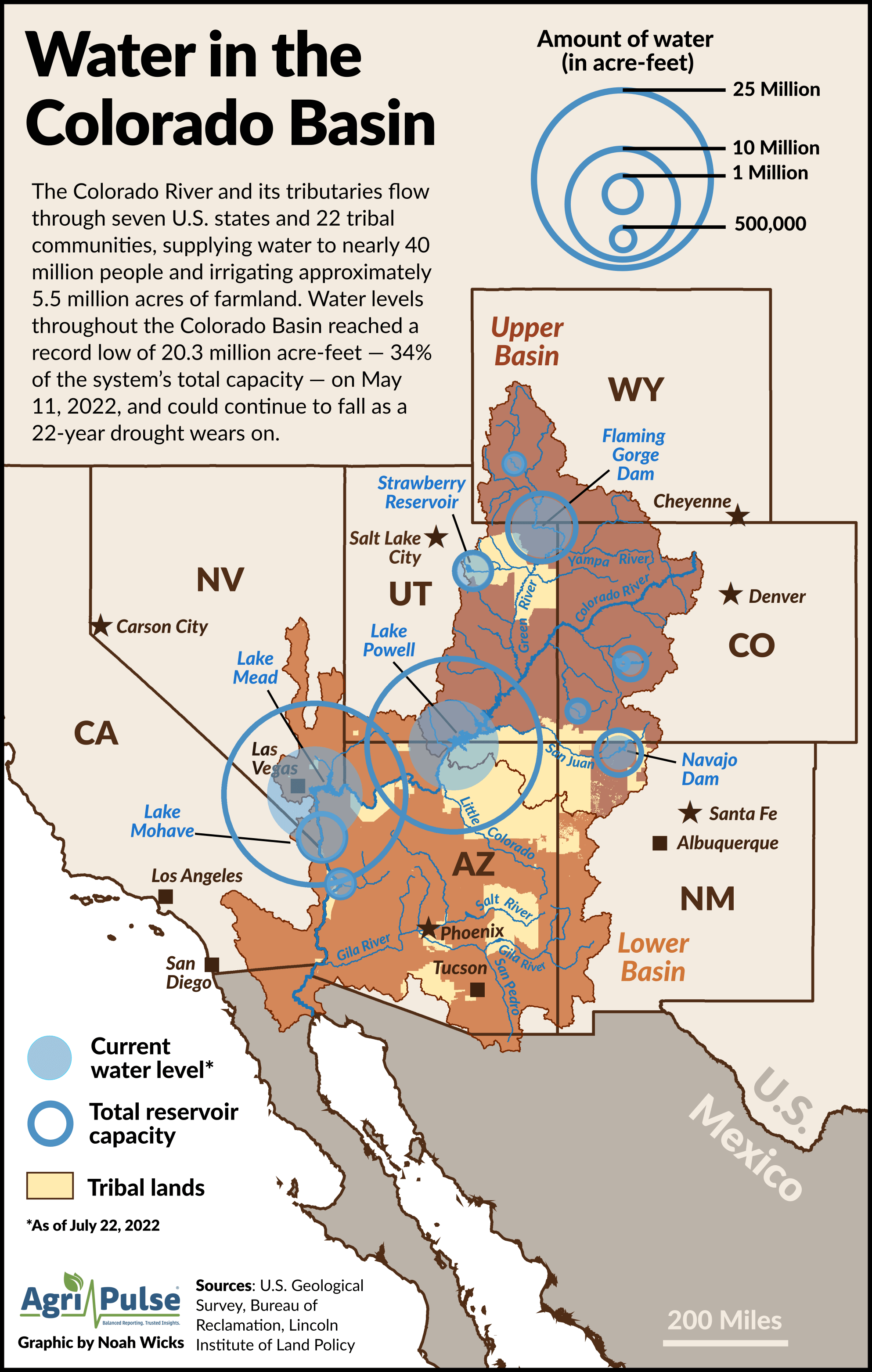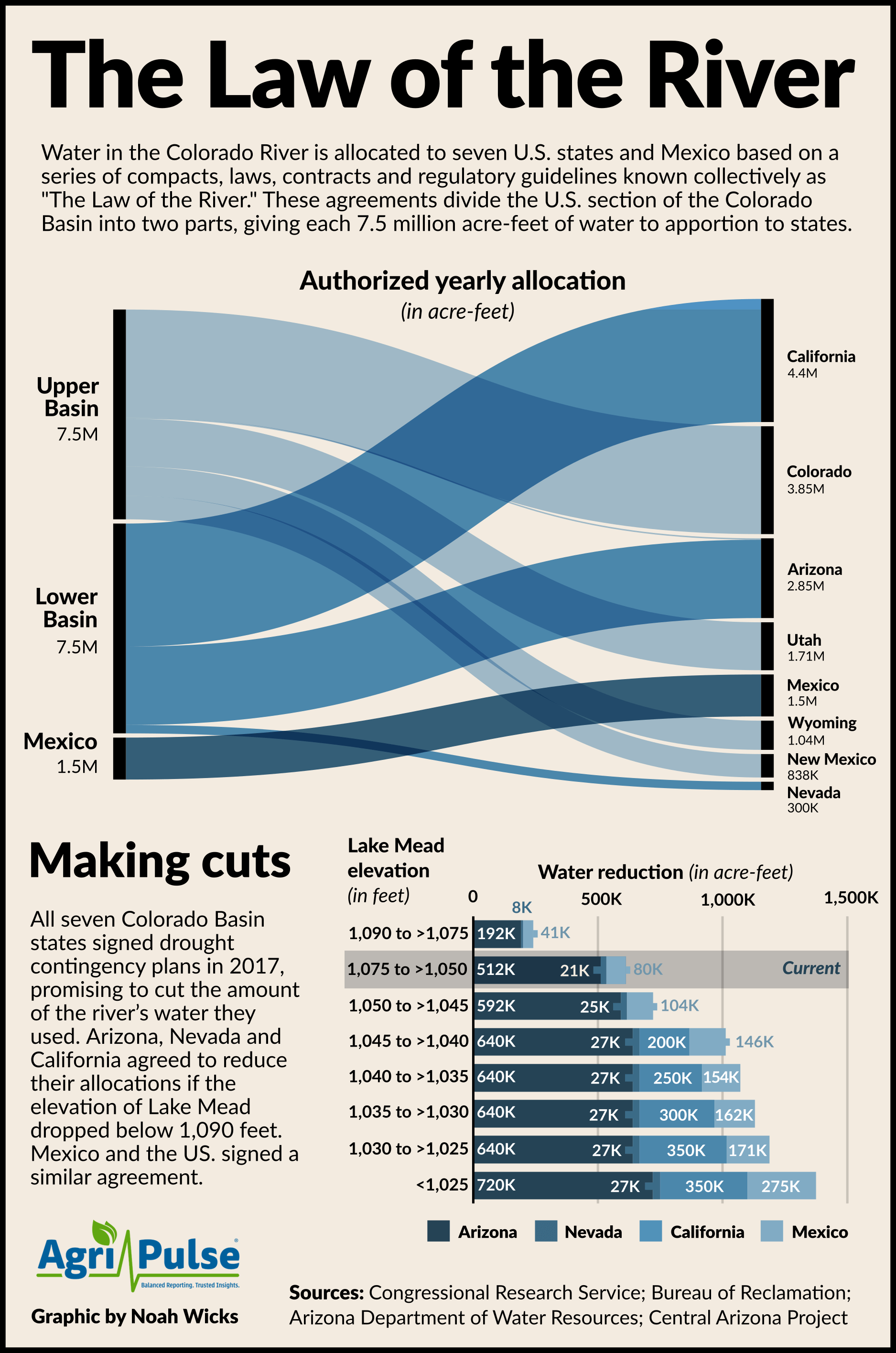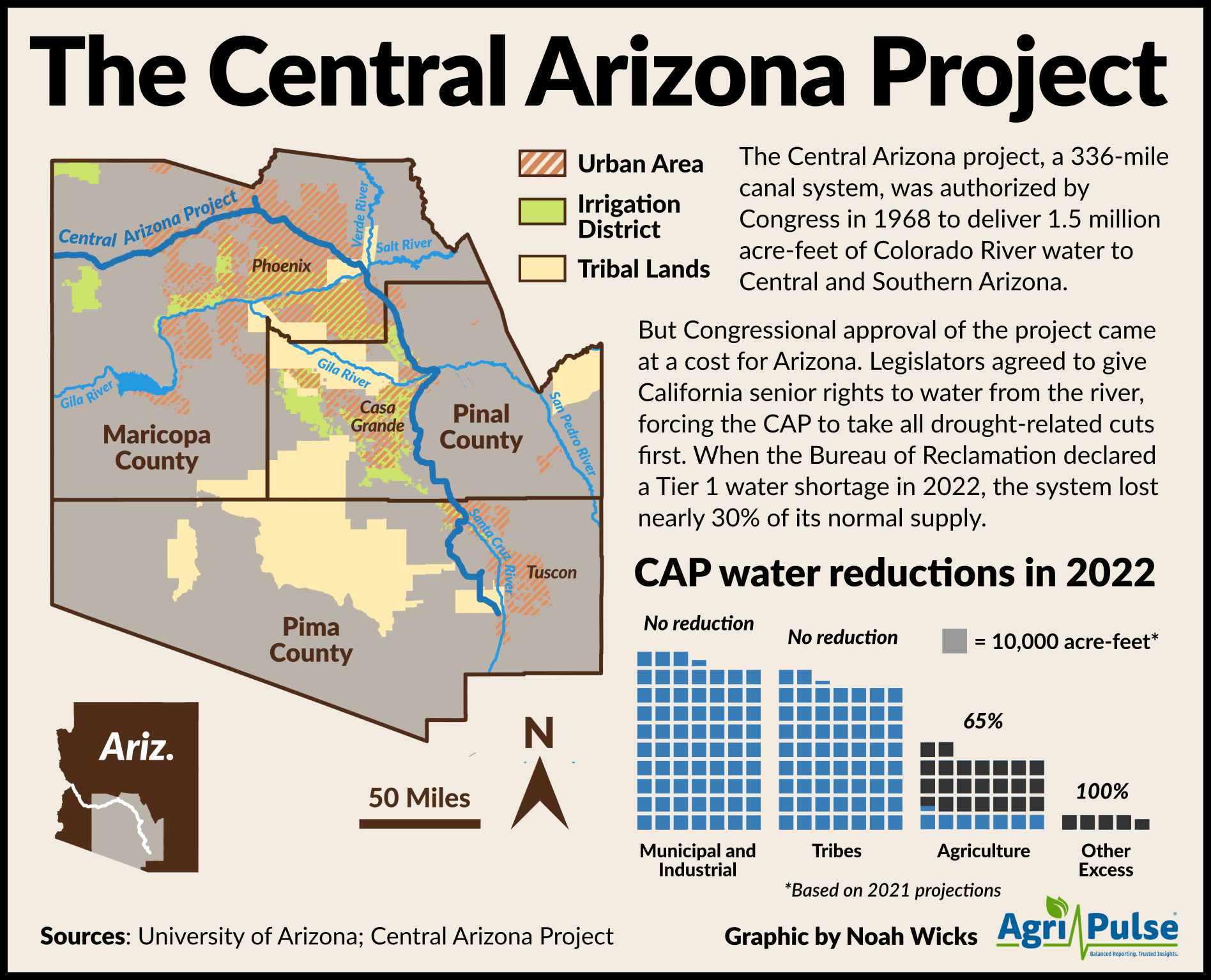Paul Ollerton always figured it would be poor markets that put him out of business. Or crops ruined by extreme heat or pest outbreaks.
But because he's been able to routinely draw from the Colorado River to irrigate his fields, the Arizona tenant farmer never pegged a lack of water as his operation’s potential doom.
It’s a fate Ollerton now fears he is nearing, as he loses access to his main water source: the Central Arizona project. The 336-mile aqueduct delivers Colorado River water to farms and households across a dusty three-county region in central Arizona, a demonstration of the mighty river’s ability to breathe life into the arid Southwest.
But the once-powerful Colorado River is now drying up. Water levels in Lake Powell and Lake Mead, its principal reservoirs, are at record lows and will continue to drop as a 22-year-long drought wears on. To protect the ailing river’s supplies, Arizona has already given up 592,000 acre-feet of its yearly allocation, while Mexico has yielded 80,000 and Nevada has sacrificed 21,000.
All three governments, along with the state of California, are bound by past treaties to increase their curtailments as water levels in Lake Mead continue to drop. Arizona’s farmers, currently receiving 65% less water from the CAP, will soon be cut off from the aqueduct’s supply entirely.
That means one of the two farms Ollerton rents will lie completely fallow next year, even though it comes with 300 acres worth of water rights. The cotton and forage crop producer will be able to use groundwater on 190 acres of the other, but an additional 90 farmable acres will go unplanted.
“It just gets harder and harder to be optimistic,” he said.
Meanwhile, all seven Colorado River Basin states are negotiating where to cut an additional 2 to 4 million acre-feet of water in 2023. They have 90 days to reach a consensus or the Bureau of Reclamation will step in and decide for them.
“The hydrology that we are seeing is unlike anything we've ever seen before and how we've managed these systems in the past no longer dictates how we do so moving forward,” Bureau of Reclamation Commissioner Camille Touton told Agri-Pulse. “We have to have these conversations collectively.”
 The discussions have already begun, multiple sources say. But the looming question is where these cuts will be made. The four states in the upper portion of the basin — Colorado, New Mexico, Utah and Wyoming — are allocated a total of 7.5 million acre-feet of water each year, but only utilize a fraction of that. Last year, for example, they took around 3.5 million acre-feet from the river.
The discussions have already begun, multiple sources say. But the looming question is where these cuts will be made. The four states in the upper portion of the basin — Colorado, New Mexico, Utah and Wyoming — are allocated a total of 7.5 million acre-feet of water each year, but only utilize a fraction of that. Last year, for example, they took around 3.5 million acre-feet from the river.
These states, in a letter to Touton last week, argued that most of the reductions would have to come from the three lower basin states — Arizona, California and Nevada — which collectively used around 7 million acre-feet of Colorado River water in 2021.
“The majority of the use is in the lower division states and we believe that’s where the majority of the cuts will have to come from in order to balance the system,” Utah Colorado River Commissioner Gene Shawcroft told Agri-Pulse.
California is a likely candidate, though the state has tightly guarded its 4.4-million-acre-foot allocation in the past. It leveraged its "senior" rights to the water in previous negotiations to hold off taking cuts until the elevation of Lake Mead drops below 1,045 feet, after the other two lower basin states and Mexico make their initial reductions.
Arizona, similarly, is bound to see its 2.85-million-acre-foot allotment slashed even more. Tom Buschatzke, the state’s water resources director, has promised to “do whatever it takes” to protect the system, though he has called for the six other basin states to make sacrifices as well.
“A solution will definitely be reached,” Buschatzke told Agri-Pulse. “I am hopeful that it will be a collaborative one among the states. If you do it collaboratively, you control who feels the pain, who gets cut and to what degree.”
Both Nevada and Arizona have felt the sting of Tier 1 water reductions, though a spokesman for the Southern Nevada Water Authority said his state has weathered them well thanks to conservation efforts dating back to 2003. But Arizona’s curtailments have chipped away at the low-priority Central Arizona Project, dealing an immediate blow to farmers that will only worsen in the next phase of cuts.
And Pinal County, an important agricultural district in the heart of the state, is where most of the impacts are being felt.
The county, which accounts for 22% of Arizona's agricultural sales, has historically been defined by cotton production and still ranks as the tenth-largest grower of the crop in the nation. A booming dairy industry, however, has recently spurred farmers to plant more alfalfa and other feed crops.
All told, farmers in the county earned around $908.1 million from direct sales in 2016, while also feeding the county’s wider $979 million agribusiness and processing sector, according to a University of Arizona study. Pinal County’s agriculture sector provides jobs for around 5,150 workers, both on and off the farm.
Don’t miss a beat! It’s easy to sign up for a FREE month of Agri-Pulse news! For the latest on what’s happening in Washington, D.C. and around the country in agriculture, just click here.
With the recent cuts, farmers in the county have already reported fallowing between 30% and 40% of the cropland they have water rights to, according to Buschatzke. But once they are completely cut off from the CAP, economists estimate that between 54,500 and 71,100 acres could sit idle, a potential $95 million to $104 million loss in county sales.
University of Arizona economist George Frisvold says the fallowing will mostly have localized effects, which means it won’t substantially affect markets outside of the state.
 However, between 270 and 480 of the county’s workers are at risk of losing their jobs, which Frisvold warns would leave them with financial challenges that could linger for years. James Andriano, who runs his own custom harvesting business, may be among them.
However, between 270 and 480 of the county’s workers are at risk of losing their jobs, which Frisvold warns would leave them with financial challenges that could linger for years. James Andriano, who runs his own custom harvesting business, may be among them.
“I'm too young to retire and it could come to a point where I don’t have any income,” Andriano said. “I could have zero acres to work next year.”
It’s not only hits to the CAP that have Pinal County farmers struggling, but also water shortages in the Gila River, a tributary of the Colorado. Take Nancy Caywood, who sits on her 92-year-old farm near Casa Grande and worries about her crops, her finances and her future.
Caywood has historically turned to the San Carlos reservoir for much of her water. But the lake, capable of holding 19,500 acre-feet of water, currently contains only 1,102 acre-feet. She was cut off from the reservoir’s supplies in June.
Caywood and her son, who farm together, have decided not to plant a cotton crop this year. Instead, they are fallowing 127 acres of land and trying to get as many alfalfa cuttings from the remaining 120 acres as they can. They’ve gotten three so far this year.
They’ll still have to make enough to pay off their tax bill, which included $19,456 for their local irrigation district last year. They’re also facing the same steep costs for fuel and inputs that other farmers are, since they still need to maintain the fields and control weeds.
“Everything is going up and we’re not able to plant to compensate for any of it,” Caywood said.
The farmers who are able to access groundwater through pumps and wells may be able to fend off the worst impacts of limited Colorado River access, though Frisvold says most will still need to fallow at least some of their land.  These farmers, he says, are already using groundwater on as much of it as they can.
These farmers, he says, are already using groundwater on as much of it as they can.
Others, like Ollerton, do not have the infrastructure they need to irrigate most of their acres with groundwater. They'll maintain these fields, keep them clear of weeds, but ultimately, they'll have no choice but to let them sit idle.
“Pinal County's agricultural community has been the mainstay for a century,” said Steve Miller, the chairman of the county’s board of supervisors. “It's been what these people made a living off of for so long and it's difficult for some of them to watch it dissipate.”
As Caywood lays awake at night, waiting for a rainstorm to roll through and wash the pain away, she thinks about all of it: her fallowed fields, the rising costs of inputs, and the tax bills she needs to pay to keep farming on the property.
But, mostly, she thinks about her son.
“I look at the worry lines on Travis's face and I just worry about him,” she said. “What are we gonna do? We don't know yet. I just know that our future is very uncertain and that we're sad. We're very sad.”
For more news, go to www.Agri-Pulse.com.


